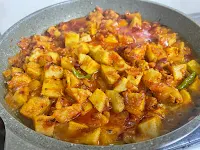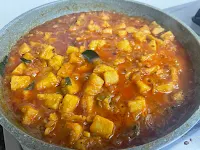How to prepare kandapulusu | Kanda Pulusu Curry recipe | Kanda Soup Recipe | How to make kanda soup | How to make Yam Curry | Kandagadda soup recipe | Amorphophallus Paeonniifolius recipes | Yam Curry recipe | Stink Lily Curry recipe | White Spot Giant Arum recipes | Elephant Foot Yam Curry | Kandagadda Koora Recipe | Kandagadda Curry Recipe | Indian Elephant Yam Curry | South Indian Yam Curry
Yam Curry (Kanda Gadda
Curry):
- Preparation Time: 20 minutes
- Cooking Time: 30 minutes
- Total Time: 50 minutes
- Servings: 4-6
1. Introduction:
Yam Curry, also known as
Kanda Gadda Curry in some regions, is a delightful Indian dish that celebrates
the robust flavors of yam combined with a harmonious blend of spices and
aromatics. This curry is a popular choice in many households, offering a
comforting and satisfying meal experience. Its versatility makes it suitable
for various occasions, from everyday meals to special gatherings.
2. Importance
of Ingredients:
- Yam (Kanda/Elephant Foot
Yam/Suran): Yam is the star ingredient of this dish, known for its
starchy texture and earthy flavor. It's rich in carbohydrates, dietary fiber,
and essential minerals like potassium and manganese.
- Spices (Mustard Seeds,
Cumin Seeds, Chili Powder, and Turmeric): These spices not only
enhance the flavor but also contribute health benefits such as
anti-inflammatory properties and digestive aid.
- Garlic and Onion: These
aromatics provide depth and richness to the curry while offering potential
health benefits like immune support and heart health.
- Tomatoes: Optional
but recommended for added tanginess and vitamin C content.
- Amchur (Dry Mango Powder): Adds
a tangy flavor and is rich in antioxidants.
- Jaggery: Balances
the spiciness and acidity with a subtle sweetness, providing energy and
minerals.
- Curry Leaves and
Coriander Leaves: Fresh herbs that elevate the aroma and freshness of the
dish.
3. Occasions
and Who Can Enjoy It:
Yam Curry is a versatile
dish that can be enjoyed on various occasions:
- Daily Meals: Perfect
for a comforting family dinner served with rice or bread.
- Festive Occasions: Adds
a homely touch to festive spreads, complementing other traditional dishes.
- Special Gatherings: Ideal
for impressing guests with its unique flavors and heartiness.
This dish
is suitable for:
- Vegetarians and Vegans: It's
a completely plant-based dish.
- Health-conscious
individuals: Yam is nutritious and provides essential nutrients.
- Those looking for
gluten-free options: When served with rice or gluten-free bread.
- Anyone who enjoys rich,
flavorful curries: The spices and textures appeal to a wide range of palates.
4. Benefits
and Uses of Having This Recipe:
- Nutritious: Provides
a good balance of carbohydrates, proteins, and essential minerals.
- Satisfying: Offers a
filling and wholesome meal experience.
- Easy to Prepare: Requires
simple ingredients and basic cooking techniques.
- Adaptable: Can
be customized with additional vegetables or adjusted spice levels.
- Cultural Significance: Reflects
traditional Indian culinary practices and flavors.
5. Ingredients:
- 300-400
grams Yam (Kanda/Elephant Foot Yam/Suran), peeled and cut into pieces
- 1
teaspoon Mustard Seeds
- 1
teaspoon Cumin Seeds
- 3-4
teaspoons Oil
- Salt
to taste
- 2
teaspoons Chili Powder
- 1
teaspoon Turmeric Powder
- 2
large Onions, finely chopped
- 1-2
Tomatoes, sliced or pureed (optional)
- 2-3
teaspoons Amchur (Dry Mango Powder)
- 20
grams Jaggery
- 5
Garlic cloves, minced
- Curry
Leaves
- Fresh
Coriander Leaves, chopped
- 2-3
cups Water
- 1
teaspoon Roasted Cumin Powder
6. Detailed
Cooking Instructions:
Preparing
the Yam (Kanda Gadda):
1. Peeling and Cutting:
Start by peeling the outer skin of the yam. It's advisable to wear gloves as
yam can sometimes cause skin irritation. Cut the peeled yam into uniform pieces
to ensure even cooking.
2. Cooking the Yam:
- Stovetop
Method: Place the yam pieces in a large pot or vessel. Cover them with
water and bring to a boil. Reduce the heat to medium and cook until the yam is
tender but still firm, about 10-15 minutes. Drain and set aside.
- Pressure
Cooker Method: Alternatively, place the yam pieces in a pressure
cooker with a cup of water. Cook for 2 whistles, then allow the pressure to
release naturally. Let it cool before opening.
3. Draining and Cooling: Once
cooked, drain the excess water from the yam pieces. Rinse them with cold water
to stop the cooking process. This helps retain their shape and prevents them
from becoming mushy.
Cooking the Curry:
4. Preparing the Spice Base: Heat
oil in a large pan or kadai over medium heat. Once the oil is hot, add mustard
seeds and cumin seeds. Allow them to splutter, releasing their flavors into the
oil.
5. Sautéing Aromatics: Add
finely chopped onions to the pan. Sauté until they turn golden brown and
caramelized. This step adds sweetness and depth to the curry base.
6. Adding Spices: Stir
in salt, chili powder, turmeric powder, and minced garlic. Fry the mixture
until the raw smell of the garlic dissipates and the spices are well-roasted.
7. Incorporating Tomatoes
(Optional): Add sliced tomatoes or tomato puree to the pan. Cook until
the tomatoes break down and the mixture becomes thick and fragrant.
8. Enhancing
Flavor: Sprinkle amchur (dry mango powder) and roasted cumin powder
over the mixture. Stir to combine, allowing the spices to blend well with the
other ingredients.
9. Integrating
Yam: Gently add the cooked yam pieces to the pan. Carefully coat
each piece with the spice mixture, ensuring they are evenly covered.
10. Adding
Water: Pour 2-3 cups of water into the pan, depending on your
desired consistency for the curry. Bring the mixture to a gentle boil.
11. Incorporating
Jaggery: Add jaggery to the curry. Stir until it dissolves completely,
balancing out the spiciness and acidity with a subtle sweetness.
12. Simmering: Toss
in curry leaves for added aroma and simmer the curry on low heat. Allow it to
cook uncovered, stirring occasionally, until the flavors meld together and the
curry reaches your desired thickness. This usually takes about 10-15 minutes.
13. Finishing
Touches: Just before serving, garnish the curry with freshly chopped
coriander leaves. Coriander adds a burst of freshness and color to the dish.
14. Serving: Turn
off the heat and let the curry sit for a few minutes to allow the flavors to
fully develop. Serve hot with steamed rice or your favorite Indian bread.
7. Storage:
- Refrigeration: Leftover
Yam Curry can be stored in an airtight container in the refrigerator for up to
2-3 days. Reheat gently on the stovetop or in the microwave before serving.
- Freezing: While
yam curry can be frozen, the texture of yam may change upon thawing. It's best
enjoyed fresh for optimal taste and texture.
8. Health
Benefits and Uses:
- Nutritious: Yam is a
good source of dietary fiber, potassium, manganese, and antioxidants.
- Digestive Health: The
spices used in the curry, such as cumin and turmeric, aid digestion and may
alleviate gastrointestinal discomfort.
- Vitamin C: Tomatoes
contribute vitamin C, which supports immune function and skin health.
- Anti-inflammatory: Garlic
and turmeric possess anti-inflammatory properties that may help reduce
inflammation in the body.
- Energy Boost: Jaggery
provides quick energy due to its high carbohydrate content.
9. Cooking Tips and Variations:
- Spice Levels: Adjust
chili powder and green chilies to suit your spice preference.
- Texture: For
a thicker curry, mash some of the cooked yam pieces before adding water.
- Vegetable Additions: Enhance
the nutritional profile by adding diced vegetables like bell peppers or
spinach.
- Creamy Variation: Stir in
coconut milk or cream for a richer, creamier texture.
10. Nutritional
Information:
- Calories: Approximately
180 kcal per serving (1/6th of the recipe)
- Protein: 3g
- Fat: 8g
- Carbohydrates: 25g
- Fiber: 5g
- Vitamin C: 20% of daily
value
- Potassium: 15% of daily
value
- Manganese: 10% of daily
value
*Nutritional
values are approximate and may vary based on specific ingredients used.*
11. Presentation
and Serving:
Yam Curry (Kanda Gadda
Curry) can be presented beautifully:
- Serve hot in a
traditional Indian serving dish.
- Garnish with a sprinkle
of freshly chopped coriander leaves for a pop of color.
- Accompany with steamed
basmati rice, roti (Indian flatbread), or naan for a complete meal experience.
Conclusion:
Yam Curry (Kanda Gadda
Curry) is not just a dish but a representation of the rich culinary heritage of
India. From its humble ingredients to its robust flavors, every element of this
curry tells a story of tradition, comfort, and nourishment. Whether enjoyed on
a regular weekday or served during festive celebrations, this dish brings
warmth and satisfaction to the table. Embrace the flavors, savor each bite, and
share this culinary delight with family and friends to create lasting memories.














Comments
Post a Comment